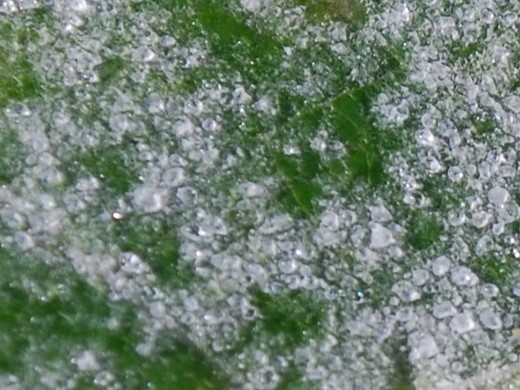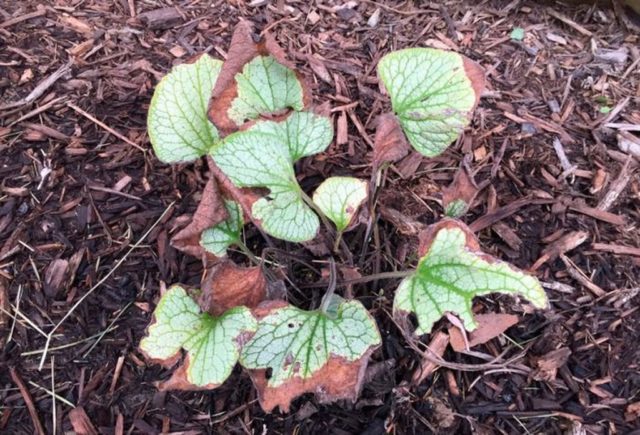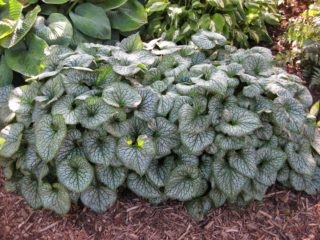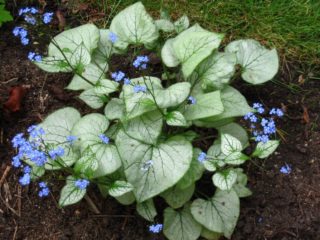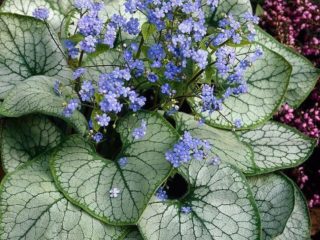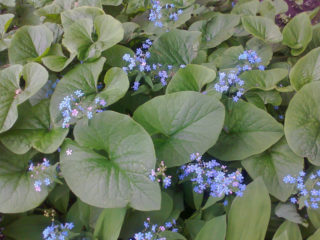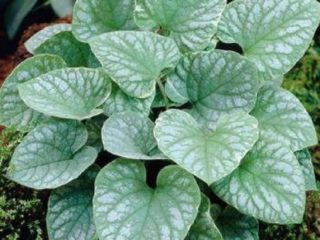Content
Large-leaved Brunner Silver Heart (Brunneramacrophylla Silver Heart) is a new impeccable variety that perfectly keeps its shape all season, grows quickly, does not lose its attractive appearance. It is a frost-hardy, shade-loving crop with a flowering period in late May or early June. The new variety of silver brunner Silver Hart is very popular and in demand among landscape designers and florists. The culture is used to decorate coastal zones of artificial reservoirs, spectacular borders, well-moistened rockeries, as a ground cover plant for shady areas.
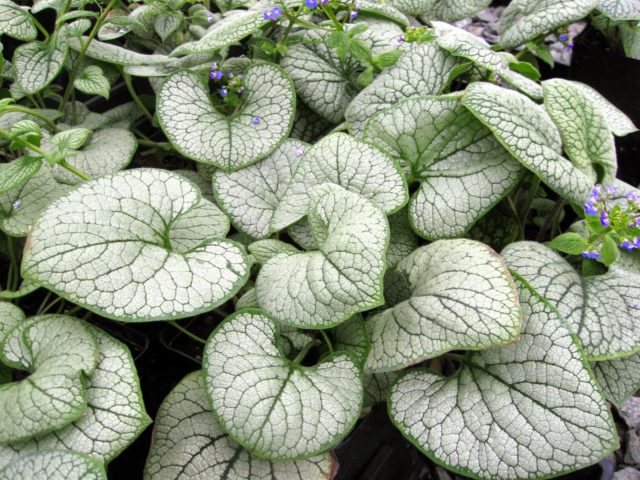
Brunner of the Silver Hart variety is an amazing plant that at the beginning of summer delights with airy "clouds" of blue-blue inflorescences, and from the middle of the summer season - hypnotizes with luxurious, large silvery foliage
Description
The new large-leaved brunner variety Silver Heart is a unique herbaceous perennial of the Boraginaceae family. The plant has the following characteristics:
- the rhizome is thick, long, with numerous basal leaves;
- bush height up to 30 cm;
- leaves are large, cordate, on elongated petioles, rough to the touch;
- the color of the leaves is silvery with greenish veins and a light green edging;
- inflorescences are paniculate or corymbose, with small flowers;
- flowers diameter 5-10 mm;
- the corolla of buds is forget-me-not;
- the color of the flowers is blue with a white center;
- height of peduncles up to 20 cm.
The Silver Hart variety differs from the Brunner Sia Hart in a paler edging (on the leaves of the SeaHeart variety, the leaf edge is more contrasting - dark green, and the leaf plates are silvery with veins).
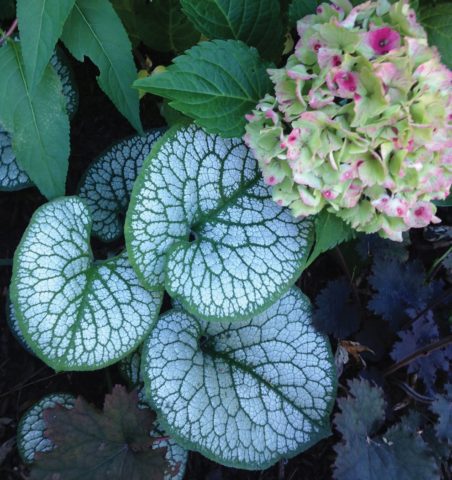
The name of the culture "Brunner Silver Hart" comes from the name of the famous Swiss botanist and explorer Samuel Brunner, who first discovered the genus Brunnera
Landing
The most suitable area for the large-leaved brunner Silver Heart is an area with predominant shade in the afternoon. Total shading can cause stretching of shoots and poor flowering of Brunner Silver. Sunny areas with a lack of natural air humidity are detrimental to moisture-loving and shade-loving crops.
The plant needs periodic rejuvenation every 3-4 years. Planting crops is carried out at any time (during the growing season), but no later than September. Experienced flower growers recommend planting brunners Silver Heart from July to August (after the end of flowering) on loamy, slightly acidic soils. Plants are transplanted on a cloudy day along with a clod of earth according to the following algorithm:
- the ground part of the mother bush is completely removed, leaving up to 10 cm of the height of the basal leaves;
- the root system is dug up and immersed in a container with water at room temperature;
- peeled roots are inspected for damage, which are cut off;
- rhizomes are divided into parts;
- plots are placed in the prepared wells;
- the roots are carefully sprinkled with soil, leaving the neck of the root system outside;
- plots are abundantly watered and mulched with sawdust, foliage or peat.

In the spring, it is not recommended for Brunner Silver Hart to transplant, since a weakened plant is more susceptible to the influence of pests and pathogens of various diseases
Care
Brunner's large-leaved variety Silver Hart is a rather unpretentious crop, subject to the correct choice of the site for its placement. The main phases of caring for an ornamental crop are reduced to the following activities:
- natural moisture (with a sufficient amount of precipitation, additional watering is not needed);
- gentle, manual removal of weeds (there is a risk of damage to the root system located under the surface of the soil);
- mulching the space under the bushes;
- top dressing with complex fertilizers in early spring before flowering;
- removal of faded inflorescences;
- autumn mulching of the ground around the bushes with fallen leaves before frost.
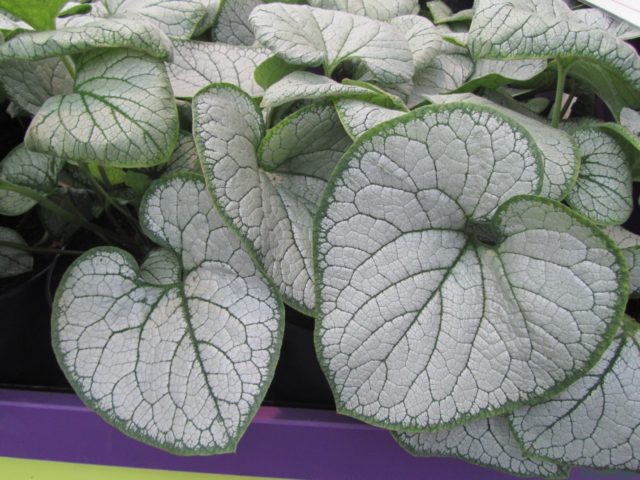
When reversible shoots with leaves appear on Brunner Silver Heart, they should be removed immediately, otherwise there is a risk of complete loss of varietal traits
Diseases and pests
Like many other garden crops, the ornamental Brunner variety Silver Heart is susceptible to fungal infections:
- Powdery mildew appears as a characteristic white (flour-like) bloom on plastic sheets. The affected areas should be treated with fungicides.
Brunner Silver Hart leaves affected by the fungus must be removed
- Brown spot also affects beautiful leaf blades, which subsequently wither and lose their decorative appeal. For the treatment of perennials, a solution of Bordeaux mixture or suitable fungicidal components are used.
To prevent the manifestation of brown spot on rainy summer days, the Brunner Silver Hart bushes are treated with fungicidal solutions twice a month
Among insect pests, aphids, whiteflies, miner moths, slugs are dangerous for silver brunners. Insect larvae quickly eat tender and juicy foliage, therefore, if pests are detected, the bushes are treated with insecticides (karbofos, actellik).
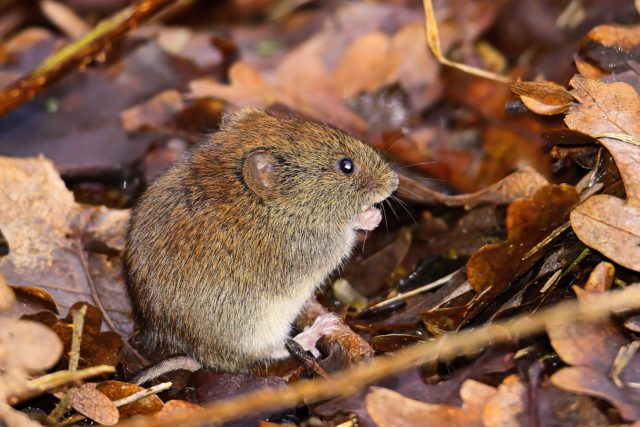
Quite often, vole mice “feast on” delicious rhizomes of the Silver Heart brunners
Pruning
To maintain an attractive appearance, after the end of flowering, the Brunners Silver Heart are cut off. Neat and well-groomed bushes delight with exquisite heart-shaped leaves, outlined with bright green paint. The second pruning is carried out in late autumn, as part of general measures to prepare plants for wintering.
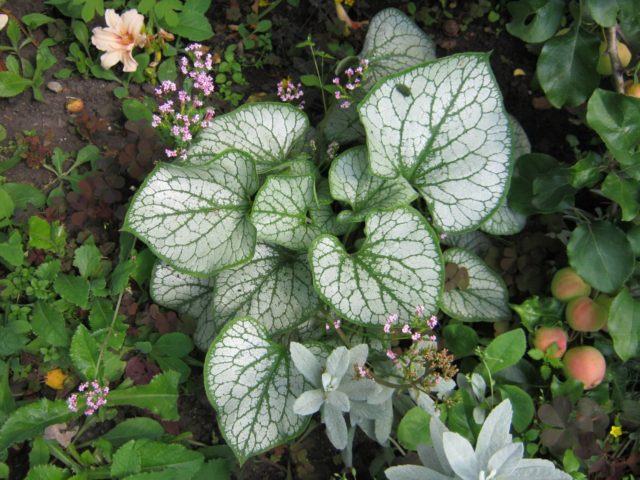
Periodically, you should trim off dried leaves that spoil the overall picture of the silver shine.
Preparing for winter
To prepare the bushes of the large-leaved brunner Silver Heart for wintering, the plants are pruned. Aerial shoots and leaves are subject to removal, which are cut off, leaving up to 15 cm of hemp. Plants require a versatile shelter. The soil around the bush is mulched with compost, foliage or peat.
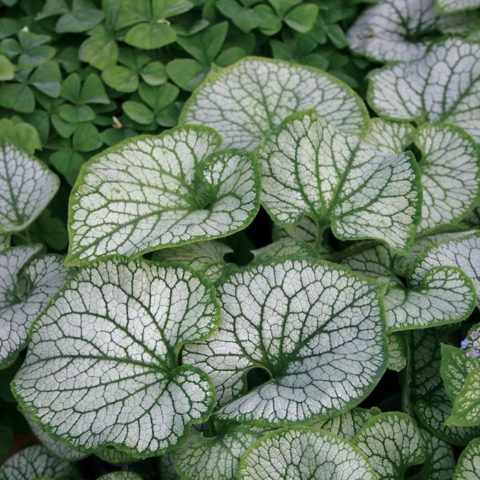
Mulching helps to protect the ground part of the plant from sudden changes in temperature
Reproduction
Brunner of the large-leaved Silver Hart can be propagated in two main ways:
- vegetative (by dividing the rhizome);
- seed (sowing seedlings and sowing seeds in open ground).
The seed method rarely gives the desired result due to the late ripening of the seeds and the low probability of maintaining varietal characteristics.
Brunner seeds bought in specialized stores can be planted directly in open ground in the fall (before the first frost). There is also a spring method of seed propagation: sowing for seedlings, slight germination of seedlings and planting seedlings in open ground.

When sowing seeds of Brunner Silver Hart in the spring, the seeds are preliminarily stratified in a refrigerator or in a special box placed in the snow for 2 months
Dividing the rhizome is the most acceptable and simple way to propagate the Silver Hart ornamental culture. The division and planting of plots in open ground is carried out after the end of the flowering of the perennial.

Plots with a sufficient number of healthy roots and buds are planted in small holes
Conclusion
The large-leaved brunner Silver Hart and its pale blue flowers are associated with forget-me-nots. In the natural environment, plants grow in Asia Minor, the foothill regions of the Caucasus, therefore the second name of the decorative culture is the forget-me-not, or Caucasian forget-me-not. Unlike other flowering plants, brunner is able to decorate the local area not only with the tenderness of the inflorescences, but also with a spectacular, unique color of curly foliage.
